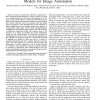Free Online Productivity Tools
i2Speak
i2Symbol
i2OCR
iTex2Img
iWeb2Print
iWeb2Shot
i2Type
iPdf2Split
iPdf2Merge
i2Bopomofo
i2Arabic
i2Style
i2Image
i2PDF
iLatex2Rtf
Sci2ools
PAMI
2010
2010
Using Language to Learn Structured Appearance Models for Image Annotation
Abstract— Given an unstructured collection of captioned images of cluttered scenes featuring a variety of objects, our goal is to simultaneously learn the names and appearances of the objects. Only a small fraction of local features within any given image are associated with a particular caption word, and captions may contain irrelevant words not associated with any image object. We propose a novel algorithm that uses the repetition of feature neighborhoods across training images and a measure of correspondence with caption words to learn meaningful feature configurations (representing named objects). We also introduce a graph-based appearance model that captures some of the structure of an object by encoding the spatial relationships among the local visual features. In an iterative procedure we use language (the words) to drive a perceptual grouping process that assembles an appearance model for a named object. Results of applying our method to three data sets in a variety of condi...
Appearance Model | Caption Words | Image | PAMI 2010 |
| Added | 29 Jan 2011 |
| Updated | 29 Jan 2011 |
| Type | Journal |
| Year | 2010 |
| Where | PAMI |
| Authors | Michael Jamieson, Afsaneh Fazly, Suzanne Stevenson, Sven J. Dickinson, Sven Wachsmuth |
Comments (0)

